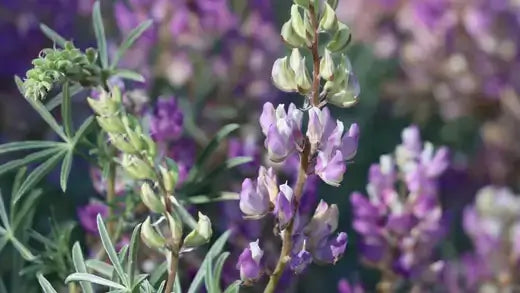Native Perennial Plants That Thrive Anywhere: A Resilient and Sustainable Landscaping Choice
Native perennial plants are a boon to gardeners and landscapers alike. They have evolved to adapt to their specific environments, making them well-suited to thrive in various conditions without excessive maintenance. Their ability to withstand local climate, soil types, and pests makes them a sustainable and eco-friendly choice for landscaping projects. Whether you're dealing with dry, arid regions, wet and marshy landscapes, or anything in between, there are native perennials that can thrive anywhere.
The Advantages of Native Perennial Plants
Native perennial plants are inherently well-equipped to handle the challenges of their natural habitats. They offer several advantages over non-native species, including:
- Climate Adaptation: Native plants have adapted to the local climate, including temperature fluctuations, rainfall patterns, and seasonal changes. This natural adaptation makes them more resilient to extreme weather events and reduces the need for intensive care.
- Soil Compatibility: Native perennials have co-evolved with local soils, allowing them to thrive without extensive soil amendments. They are adapted to the specific pH, drainage, and nutrient content of their native soil, reducing the need for fertilizers and soil modification.
- Pest and Disease Resistance: Over time, native plants have developed defenses against local pests and diseases. This means they are less susceptible to infestations and infections, reducing the need for chemical interventions.
- Water Efficiency: Once established, native perennials require less water than non-native species. Their ability to adapt to local rainfall patterns and soil moisture levels contributes to water conservation efforts.
Native Perennial Plants for Various Environments
- Dry and Arid Regions:
- Yucca: Yucca plants are known for their striking rosettes of sharp-edged leaves and tall flower spikes. They thrive in arid climates and poor soils, making them an excellent choice for xeriscaping projects.
- Agave: Agaves are succulent plants that store water in their leaves, making them highly drought-tolerant. They come in various sizes and forms, adding architectural interest to landscapes.
- Purple Coneflower (Echinacea purpurea): This flowering perennial is drought-resistant and a pollinator magnet, attracting bees and butterflies to its vibrant blooms.
- Wet and Marshy Landscapes:
- Cattails: Cattails are well-suited to wetland environments and can filter water and prevent erosion. They are a valuable addition to rain gardens and pond edges.
- Pickerelweed (Pontederia cordata): With its beautiful blue-purple flower spikes, pickerelweed thrives in moist soils and shallow waters, providing habitat and food for aquatic wildlife.
- Swamp Milkweed (Asclepias incarnata): This native milkweed variety flourishes in wetter areas and supports monarch butterflies, which lay their eggs exclusively on milkweed plants.
- Woodland and Shade Gardens:
- Wild Ginger (Asarum canadense): A groundcover plant, wild ginger thrives in shaded woodlands. Its heart-shaped leaves and unique flowers make it an attractive option for low-light areas.
- Solomon's Seal (Polygonatum spp.): These graceful plants bear dangling white flowers and thrive in woodland settings. They are adaptable to various soil types and shade levels.
- Virginia Bluebells (Mertensia virginica): Known for their charming blue, bell-shaped flowers, Virginia bluebells bloom in early spring and thrive in partially shaded areas.
- Prairie and Grasslands:
- a. Big Bluestem (Andropogon gerardii): A tallgrass prairie native, big bluestem adds height and texture to landscapes. It's drought-tolerant and supports a variety of wildlife.
- b. Black-Eyed Susan (Rudbeckia hirta): This classic prairie flower boasts vibrant yellow petals with a dark center. It's a favorite among pollinators and can thrive in various soil conditions.
- c. Prairie Dropseed (Sporobolus heterolepis): With its fine-textured foliage and delicate seed heads, prairie dropseed adds a touch of elegance to prairie gardens while thriving in dry conditions.
Establishment and Maintenance
While native perennial plants are generally hardy and low-maintenance, proper establishment and care are crucial for their success:
- Plant Selection: Choose species that are native to your region. Local native plant societies or gardening centers can provide valuable guidance on suitable choices.
- Site Preparation: Ensure proper soil preparation, considering drainage, pH levels, and sunlight requirements. Removing invasive species and providing mulch can aid in establishment.
- Watering: While most native perennials are drought-resistant once established, they require regular watering during the first growing season. After that, they will rely on natural rainfall.
- Mulching: Apply a layer of organic mulch to help retain soil moisture, suppress weeds, and regulate soil temperature.
- Pruning: Prune dead or spent foliage as needed, but avoid excessive trimming, as native plants often have specific growth patterns that benefit wildlife.
- Supporting Wildlife: Encourage biodiversity by allowing native perennials to bloom and go to seed. This provides food and habitat for pollinators, birds, and other creatures.
Conclusion
Native Perennial Plants are versatile and sustainable for landscaping projects across various environments. From deserts to wet marshes, these plants have proven their ability to thrive while requiring less maintenance and resources compared to non-native alternatives. By selecting native perennials, gardeners and landscapers can contribute to the conservation of local ecosystems, support pollinators, and create beautiful, resilient landscapes that stand the test of time.

